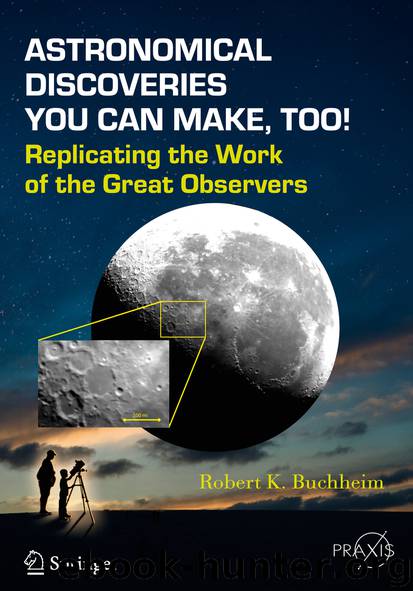Astronomical Discoveries You Can Make, Too! by Robert K. Buchheim

Author:Robert K. Buchheim
Language: eng
Format: epub
Publisher: Springer International Publishing, Cham
(Eq. 3.8)
in hours, whereΦ is your longitude, in degrees
D is T + Z – TJD0 in days
T is the date/time (e.g. the date/time of one of your images)
TJD0 is 2000 Jan 01 12:00:00 (UT)
Z is the time difference between your clock time and Universal Time19. For example, if your clock is set to USA Pacific Standard Time, then Z = 8 hours. If you followed my instructions and set your clock to UT, then Z = 0.
A spreadsheet will easily perform the necessary calculations, but there are a few tricks to using this equation. Your clock date/time, T, and the reference date/time, TJDO, should be written to the nearest second. The parameter “D” must be expressed in decimal days to an accuracy of 1 second (≈0.00001 day). Your longitude should be accurate to about ±0.05 degree (±3 minutes of arc) or better. Regarding the term “±Φ/15”, use “+” if your longitude is expressed as degrees East of Greenwich and use “– ” if it is expressed as degrees West of Greenwich. Finally, don’t round off the coefficients in Eq. 3.8; use all of the digits!
The value of “LSTE” that is returned by Eq. 3.8 will be a very large number, because that equation accumulates the changing LST day-by-day; it doesn’t re-set itself to LST = 0 at the start of each new (sidereal) day. You will need to reduce it to the range 0–24 hours of RA by
Download
This site does not store any files on its server. We only index and link to content provided by other sites. Please contact the content providers to delete copyright contents if any and email us, we'll remove relevant links or contents immediately.
Tools of Titans by Timothy Ferriss(8218)
Turbulence by E. J. Noyes(7936)
Secrets of Antigravity Propulsion: Tesla, UFOs, and Classified Aerospace Technology by Ph.D. Paul A. Laviolette(5309)
Astrophysics for People in a Hurry by Neil DeGrasse Tyson(5132)
Room 212 by Kate Stewart(5035)
Design of Trajectory Optimization Approach for Space Maneuver Vehicle Skip Entry Problems by Runqi Chai & Al Savvaris & Antonios Tsourdos & Senchun Chai(5011)
Pale Blue Dot by Carl Sagan(4912)
The David Icke Guide to the Global Conspiracy (and how to end it) by David Icke(4625)
A Journey Through Divination and Astronomy by Publishing Pottermore(4344)
Goodbye Paradise(3727)
Apollo 8 by Jeffrey Kluger(3637)
COSMOS by Carl Sagan(3554)
Losing the Nobel Prize by Brian Keating(3498)
The Five People You Meet in Heaven by Mitch Albom(3475)
How to Read Water: Clues and Patterns from Puddles to the Sea (Natural Navigation) by Tristan Gooley(3406)
Brief Answers to the Big Questions by Stephen Hawking(3369)
How to Read Nature by Tristan Gooley(3249)
The Order of Time by Carlo Rovelli(3145)
A Brief History of Time by Stephen Hawking(2960)
